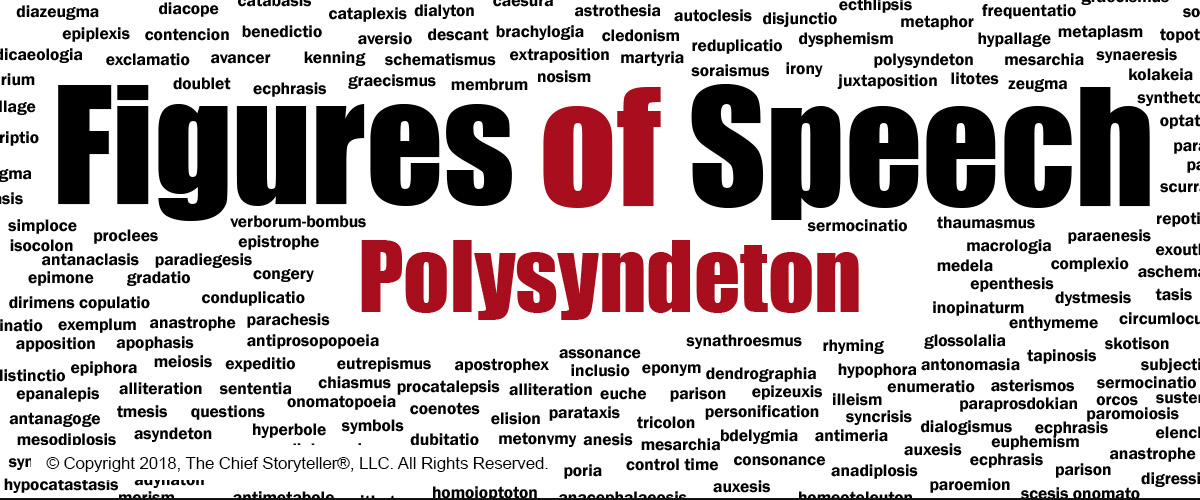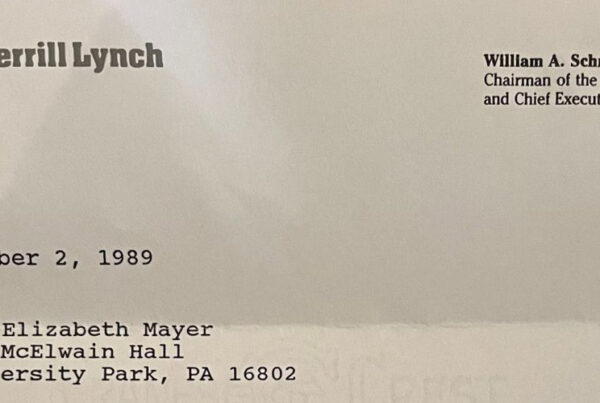
Let me introduce you to Polysyndeton, a Reinforcing Figure of Speech. It is part of a series on figures of speech and story elements.
I share them as the English language has hundreds of literary devices to help you (dramatically) improve the effectiveness and impact of your various communications.
Use Polysyndeton to strengthen your written and spoken narrative with emphasis and emotion. Polysyndeton enables you to improve memorability with your words and phrases.
Whatever your goal, what is most important is the application of each figure of speech and story element in your written, spoken, and social media communication.
When I do my consulting, workshops, training, and teach my class on public speaking and storytelling (I’m an adjunct professor at The Robert H. Smith School of Business at the University of Maryland), I tell them all…
“You never have to remember the actual Greek word for the figure of speech.
You DO have to remember the concept and proper use of it.”
Emphasis & Impact Figures of Speech include Anadiplosis, Anaphora, Asyndeton, Diacope, Epanalepsis, Epiphora, and Polysyndeton.
Amplification Figures of Speech include Auxesis and Epizeuxis,
Figures of Sound include Onomatopoeia.
Other Figures of Speech include Procatalepsis and Portmanteau.
There are three major sections:
- Figure of Speech. Includes a little background, usage, definition, pronunciation, other related figures of speech, and etymology
- Usage Guidelines. Follow these guidelines to ensure maximum impact.
- Examples of Polysyndeton. Find examples from speeches, presentations, presidential addresses, poems, music, and more
1) POLYSYNDETON – FIGURE OF AMPLIFICATION
Polysyndeton is a dramatic literary device to make your points and stories more memorable, with a repetition of rhythm. Use Polysyndeton to:
- Overwhelm your audience with a “verbal pile-up” of ideas
- Demonstrate to your audience there are a lot of ideas, reasons, etc.
- Emphasize items in a list
- Stress out your audience with so many examples
- Give equal weight to each idea in the list
- Excite your audience with a fast-paced reading/reciting of the list
- Add seriousness to each idea by reading/saying the items slowly
- Convey a child-like excitement, speaking like a child would with many conjunctions
- Make it seem like you are listing items on-the-spot
Because Polysyndeton stands out in any communication, its effectiveness typically diminishes with repeated use. Use Polysyndeton sparingly (see #2 Guidelines below).
| Definition | Polysyndeton is an impact figure of speech where you reinforce your point with a series of intentional conjunctions, using three or more conjunctions of “and” or “or” |
| Pronunciation | pol – ee – sin – dih – tahn |
| Related to | Asyndeton (antonym), Parataxis, Syndeton, and Zeugma |
| Etymology | Derived from the ancient Greek word, πολύ poly, meaning “many,” and συνδετόν syndeton, meaning “bound together with” |
2) GUIDELINES IN USING REPETITION
Here are some guidelines for you to ensure Polysyndeton, your figure of amplification, achieves your communication goals:
| Use Deliberately | The strength of Polysyndeton as an amplification figure of speech, is to use it deliberately. Using it too many times, will likely lose its impact on your audiences. In your typical three-minute story, which is about 450 words, use Polysyndeton no more than two or three times. |
| Choose a Simple Word or Phrase | If you were to analyze narratives where Polysyndeton is used, you would find the authors use simple words and simple phrases. You want to ensure your audience is able to readily remember your ideas. Simple always wins the day. See below for examples. |
| Repeat 4 Times or More |
Since humans look for and respond to patterns, I recommend using at least three instances of the same conjunction of “and” or “or” and “to.” More likely, four or five instances will better demonstrate your use of Polysyndeton. See examples below for usage. |
| Emphasize with Your Voice | In my training and teaching, I share specifics on how to use one’s voice to add (dramatic) impact to your spoken communication. Think of yourself as an orchestra with three main instruments: Your Words, your Body Language, and your Voice. Varying your tone of voice, cadence, and speed are what separates a great speaker from a good speaker. |
3) EXAMPLES OF POLYSYNDETON
Look at the examples below. See how Polysyndeton is used to dramatically increase the effectiveness and impact of your words. Then experiment, mixing and combining other figures of speech in your written, spoken, and social media communication.
Example 1: U.S. Coast Guard Academy Commencement Address, 2008 – DeCarol Davis
| Without Notation | I simply ask you to think. I ask you to look back on your moments of powerlessness. Look back to that moment where you had to get on your knees and scrub and sweep and mop and wax and buff and buff and buff and rebuff, and buff again, a floor that someone was going to walk on and probably scuff two minutes later. That feeling is what it is to be human. |
| With Notation |
I simply ask you to think. I ask you to look back on your moments of powerlessness. Look back to that moment where you had to get on your knees and scrub and sweep and mop and wax and buff and buff and buff and rebuff, and buff again, a floor that someone was going to walk on and probably scuff two minutes later. That feeling is what it is to be human.
This example is a bit complex, employing four different figures of repetition. Anaphora. “I ask you” starts two sentences Anadiplosis. Look back in the middle then starts the next sentence Diacope. Repeated use of buff Source: American Rhetoric |
Example 2: U.S. Postal Service Informal Motto
| Without Notation | “Neither snow nor rain nor heat nor gloom of night stays these couriers from the swift completion of their appointed rounds” |
| With Notation |
“Neither snow nor rain nor heat nor gloom of night stays these couriers from the swift completion of their appointed rounds” |
Example 3: President Ronald Reagan’s Speech on the Challenger Disaster
| Without Notation | “We will always remember them, these skilled professionals, scientists and adventurers, these artists and teachers and family men and women, and we will cherish each of their stories—stories of triumph and bravery, stories of true American heroes.” |
| With Notation |
“We will always remember them, these skilled professionals, scientists and adventurers, these artists and teachers and family men and women, and we will cherish each of their stories—stories of triumph and bravery, stories of true American heroes.” |
Example 4: Quentin Fottrell, Market Watch column, 2022
| Without Notation | When you have spent your life being a good mother and a good wife, and a good daughter, and a good person overall, and have cooperated and acquiesced and supported others, it’s a change of perspective to have the means and freedom to turn all of that energy on yourself. |
| With Notation |
When you have spent your life being a good mother and a good wife and a good daughter and a good person overall, and have cooperated and acquiesced and supported others, it’s a change of perspective to have the means and freedom to turn all of that energy on yourself. |
Example 5: New York Times Article by Helen Macdonald, 2021
| Without Notation | The screenwriter Jon Spaihts described him as “generous and humble and charming and everything you could want in a creative partner.” |
| With Notation |
The screenwriter Jon Spaihts described him as “generous and humble and charming and everything you could want in a creative partner.” |
References: I use a combination of my experience, my personal library of books and journals, sources from the Internet, and my 710-plus page Story Elements Resource Guide. My favorite sources include, in alphabetical order: American Rhetoric, Encyclopedia Britannica, LitCharts, Literary Devices, Merriam-Webster Dictionary, Oxford English Dictionary, Silva Rhetoricae, and ThoughtCo. My favorite books include: A Handbook of Rhetorical Devices by Robert A. Harris; Elements of Eloquence by Mark Forsyth; and A Handlist of Rhetorical Terms, 2nd Edition by Richard A. Lanham.
Photography Source: Updated 2022 – Message Cloud/Word Cloud designed by The Chief Storyteller®, LLC. © Copyright 2022. All Rights Reserved.
#chiefstoryteller #communication #figuresofspeech #language #rhetoric



